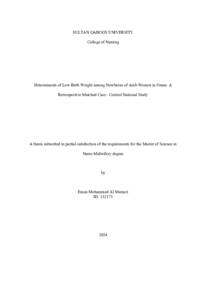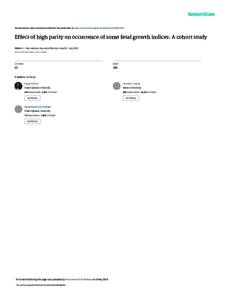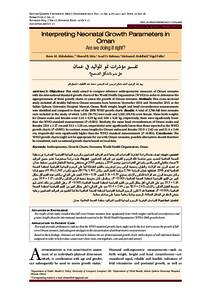وثيقة
Determinants of low birth weight among newborns of Arab women in Oman : a retrospective matched case-control national study.
المصدر
Master's thesis
عناوين أخرى
محددات انخفاض الوزن عند الأطفال حديثي الولادة في عمان : دراسة حالة - مراقبة رجعية وطنية.
الدولة
Oman
مكان النشر
Muscat
الناشر
Sultan Qaboos University.
ميلادي
2024
اللغة
الأنجليزية
نوع الرسالة الجامعية
Master's thesis
الملخص الإنجليزي
Background:
Low birth weight (LBW) has been linked to several short and long-term adverse health problems such as cognitive and behavioral developmental delays, neurological problems, and incidence of chronic health problems such as hypertension, coronary heart disease, diabetes, and stroke. In Oman, the incidence of LBW is on the rise. It increased from 4.2% in 1980 to 12.0% in 2021. According to the latest statistics from Oman Ministry of Health, LBW is the first leading cause of inpatient morbidity among newborns who are less than 7 days of age. Previous studies on the determinants of LBW have focused mainly on Western countries, limiting the generalizability of the findings of these studies to Arab countries, where the burden of LBW is highest due to cultural, economic, and healthcare differences. Variations in dietary habits, genetic factors, and environmental conditions also play significant roles.
Purpose:
To examine the determinants of low birth weight among newborns of Arab women in Oman.
Methods:
A retrospective matched (1:1) case-control study design was conducted to answer the study aim. Four hundred and fourteen (414) participants were included in the study, assuming power of 80%, with alpha level 0.05, two-tailed, and a small effect size of 0.1. The setting for this study was the delivery units of five major tertiary hospitals in Oman, namely Royal Hospital, Khoula Hospital, Sultan Qaboos University Hospital, Nizwa Hospital, and Suhar Hospital. The measurement tool included a standardized report form developed by the study's principal investigator based on an extensive literature review on the determinants of low birth weight. The analytical tools included Chi-square test and fitting binary logistic regression for the outcome LBW (case vs. control) and determinants of LBW.
Results:
The logistic regression results showed that Nagelkerker R Square was 0.271, suggesting that 27.1% of the variance in low birth weight was explained by the variables included in the model, and the model was statistically significant (χ²(27) = 92.737, p 0.001). Total weight gain (β = -0.004, p 0.05), baby gender (β = 0.685, p 0.05), presence of IUGR (β = 1.82, p 0.05), and hemoglobin level at delivery (β = -0.010, p 0.05) were significant determinants of low birth weight. The sensitivity of the model to correctly predict LBW cases was 67.0%, and the specificity was 71.8%. Overall, the model correctly classified 69.4% of the cases.
Conclusion:
This study is aligned with Oman’s Health Research Priorities in 2014. Generally, the findings from this study are expected to inform the policymakers in Oman Ministry of Health about the determinants of LBW and subsequently adopt culturally sensitive strategies and health policies to curb the incidence of LBW in Oman. This is an essential future strategy to be taken into consideration, given the fact that Oman is undergoing an epidemiological transition and facing a mounting morbidity burden.
Implications for Practice and Policy:
The implications for practice and policy in addressing LBW highlight the necessity for targeted interventions. In clinical practice, healthcare providers should emphasize maternal nutrition education, early identification, and management of medical conditions, along with interventions addressing lifestyle factors. From a policy standpoint, there is a need for accessible and quality prenatal care initiatives, particularly focusing on high-risk populations. Public health campaigns should raise awareness about the impact of maternal lifestyle choices. Collaborative efforts between healthcare providers, policymakers, and communities are essential to comprehensively address LBW determinants and improve maternal and neonatal outcomes.
الملخص العربي
الخلفية:
تم ربط انخفاض الوزن عند المواليد بالعديد من المشاكل الصحية الضارة قصيرة وطويلة الأجل مثل تأخر النمو المعرفي والسلوكي، والمشاكل العصبية، وحدوث مشاكل صحية مزمنة مثل ارتفاع ضغط الدم وأمراض القلب التاجية والسكري والسكتة الدماغية. في عمان، فإن معدل الإصابة بنقص الوزن عند المواليد في ارتفاع مطرد، حيث ارتفعت النسبة من 4.2% في عام 1980 إلى 12.0% في عام 2021. ووفقًا لأحدث الإحصاءات الصادرة عن وزارة الصحة العمانية، فإن انخفاض الوزن عند المواليد هو السبب الرئيسي الأول لمراضة المرضى الداخليين بين الأطفال حديثي الولادة الذين تقل أعمارهم عن 7 أيام. ولقد ركزت الأدلة السابقة على نقص الوزن عند المواليد بشكل أساسي على الدول الغربية، مما يحد من إمكانية تعميم نتائج هذه الدراسات على الدول العربية، حيث يكون عبء نقص الوزن عند المواليد هو الأعلى. بالإضافة إلى ذلك، هناك نقص في الأدلة على دور العوامل الاجتماعية والثقافية في نقص الوزن عند المواليد بين الأمهات العربيات.
الغرض:
دراسة محددات انخفاض الوزن بين الأطفال حديثي الولادة من النساء العربيات في عمان.
الطرق:
تم إجراء تصميم دراسة الحالات والشواهد بأثر رجعي المطابق (1:1) للإجابة على هدف الدراسة. تم تضمين أربعمائة وأربعة عشر (414) مشاركًا في الدراسة، بافتراض قوة 80%، بمستوى ألفا 0.05، وحجم تأثير صغير (0.1). وتم إجراء هذه الدراسة في وحدات الولادة في خمسة مستشفيات رئيسية من الدرجة الثالثة في عمان، وهي المستشفى السلطاني ومستشفى خولة ومستشفى جامعة السلطان قابوس ومستشفى نزوى ومستشفى صحار. تضمنت أداة القياس نموذج تقرير موحد تم تطويره بواسطة الباحث الرئيسي بالدراسة بناءً على مراجعة واسعة النطاق للأدبيات حول محددات انخفاض الوزن عند الولادة. وشملت الأدوات التحليلية اختبار مربع تشي والانحدار اللوجستي الثنائي المناسب.
النتائج:
أظهرت نتائج الانحدار اللوجستي أن Nagelkerker R Square كان 0.271، مما يشير إلى أن 27.1% من التباين في انخفاض الوزن عند الأطفال حديثي الولادة تم تفسيره من خلال المتغيرات المدرجة في النموذج، وكان النموذج ذو دلالة إحصائية (χ²(27) = 92.737، p < 0.001). وتشير النتائج أيضًا إلى أن إجمالي زيادة الوزن للأم (β = -0.004, p < 0.05)، جنس الطفل (β = 0.685, p < 0.05)، وجود تقييد في نمو الجنين داخل الرحم (β = 1.82, p < 0.05)، ومستوى هيموجلوبين الأم عند الولادة (β = -0.010, p < 0.05) كانت محددات هامة لانخفاض الوزن عند الأطفال حديثي الولادة. كانت حساسية النموذج للتنبؤ بشكل صحيح بحالات نقص الوزن عند المواليد 67.0%، والنوعية 71.8%. وبشكل عام، صنف النموذج بشكل صحيح 69.4% من الحالات.
الاستنتاج:
تتماشى هذه الدراسة مع أولويات البحوث الصحية في سلطنة عمان في عام 2014. وبشكل عام، من المتوقع أن تُثري نتائج هذه الدراسة صناع السياسات في وزارة الصحة العمانية حول محددات نقص الوزن عند المواليد، ومن ثم اعتماد استراتيجيات وسياسات صحية حساسة ثقافيًا للحد من هذه الظاهرة. هذه استراتيجية مستقبلية أساسية يجب أخذها بعين الاعتبار، نظرًا لحقيقة أن عمان تمر بمرحلة انتقالية وبائية وتواجه عبئًا مرضيًا متزايدًا.
الآثار المترتبة على الممارسة والسياسة:
إن الآثار المترتبة على الممارسة والسياسة في معالجة نقص الوزن عند المواليد تسلط الضوء على ضرورة التدخلات المستهدفة. في الممارسة السريرية، يجب على مقدمي الرعاية الصحية التركيز على التثقيف الغذائي للأمهات، والكشف المبكر، وإدارة الحالات الطبية، إلى جانب التدخلات التي تعالج عوامل نمط الحياة. من وجهة نظر السياسة الصحية، هناك حاجة إلى مبادرات رعاية ما قبل الولادة عالية الجودة ويمكن الوصول إليها، مع التركيز بشكل خاص على المجموعات السكانية المعرضة للخطر. يجب أن تعمل حملات الصحة العامة على رفع مستوى الوعي حول تأثير خيارات نمط حياة الأم. تعد الجهود التعاونية بين مقدمي الرعاية الصحية وواضعي السياسات والمجتمعات ضرورية لمعالجة محددات نقص الوزن عند المواليد بشكل شامل وتحسين نتائج الأمهات والأطفال حديثي الولادة.
تم ربط انخفاض الوزن عند المواليد بالعديد من المشاكل الصحية الضارة قصيرة وطويلة الأجل مثل تأخر النمو المعرفي والسلوكي، والمشاكل العصبية، وحدوث مشاكل صحية مزمنة مثل ارتفاع ضغط الدم وأمراض القلب التاجية والسكري والسكتة الدماغية. في عمان، فإن معدل الإصابة بنقص الوزن عند المواليد في ارتفاع مطرد، حيث ارتفعت النسبة من 4.2% في عام 1980 إلى 12.0% في عام 2021. ووفقًا لأحدث الإحصاءات الصادرة عن وزارة الصحة العمانية، فإن انخفاض الوزن عند المواليد هو السبب الرئيسي الأول لمراضة المرضى الداخليين بين الأطفال حديثي الولادة الذين تقل أعمارهم عن 7 أيام. ولقد ركزت الأدلة السابقة على نقص الوزن عند المواليد بشكل أساسي على الدول الغربية، مما يحد من إمكانية تعميم نتائج هذه الدراسات على الدول العربية، حيث يكون عبء نقص الوزن عند المواليد هو الأعلى. بالإضافة إلى ذلك، هناك نقص في الأدلة على دور العوامل الاجتماعية والثقافية في نقص الوزن عند المواليد بين الأمهات العربيات.
الغرض:
دراسة محددات انخفاض الوزن بين الأطفال حديثي الولادة من النساء العربيات في عمان.
الطرق:
تم إجراء تصميم دراسة الحالات والشواهد بأثر رجعي المطابق (1:1) للإجابة على هدف الدراسة. تم تضمين أربعمائة وأربعة عشر (414) مشاركًا في الدراسة، بافتراض قوة 80%، بمستوى ألفا 0.05، وحجم تأثير صغير (0.1). وتم إجراء هذه الدراسة في وحدات الولادة في خمسة مستشفيات رئيسية من الدرجة الثالثة في عمان، وهي المستشفى السلطاني ومستشفى خولة ومستشفى جامعة السلطان قابوس ومستشفى نزوى ومستشفى صحار. تضمنت أداة القياس نموذج تقرير موحد تم تطويره بواسطة الباحث الرئيسي بالدراسة بناءً على مراجعة واسعة النطاق للأدبيات حول محددات انخفاض الوزن عند الولادة. وشملت الأدوات التحليلية اختبار مربع تشي والانحدار اللوجستي الثنائي المناسب.
النتائج:
أظهرت نتائج الانحدار اللوجستي أن Nagelkerker R Square كان 0.271، مما يشير إلى أن 27.1% من التباين في انخفاض الوزن عند الأطفال حديثي الولادة تم تفسيره من خلال المتغيرات المدرجة في النموذج، وكان النموذج ذو دلالة إحصائية (χ²(27) = 92.737، p < 0.001). وتشير النتائج أيضًا إلى أن إجمالي زيادة الوزن للأم (β = -0.004, p < 0.05)، جنس الطفل (β = 0.685, p < 0.05)، وجود تقييد في نمو الجنين داخل الرحم (β = 1.82, p < 0.05)، ومستوى هيموجلوبين الأم عند الولادة (β = -0.010, p < 0.05) كانت محددات هامة لانخفاض الوزن عند الأطفال حديثي الولادة. كانت حساسية النموذج للتنبؤ بشكل صحيح بحالات نقص الوزن عند المواليد 67.0%، والنوعية 71.8%. وبشكل عام، صنف النموذج بشكل صحيح 69.4% من الحالات.
الاستنتاج:
تتماشى هذه الدراسة مع أولويات البحوث الصحية في سلطنة عمان في عام 2014. وبشكل عام، من المتوقع أن تُثري نتائج هذه الدراسة صناع السياسات في وزارة الصحة العمانية حول محددات نقص الوزن عند المواليد، ومن ثم اعتماد استراتيجيات وسياسات صحية حساسة ثقافيًا للحد من هذه الظاهرة. هذه استراتيجية مستقبلية أساسية يجب أخذها بعين الاعتبار، نظرًا لحقيقة أن عمان تمر بمرحلة انتقالية وبائية وتواجه عبئًا مرضيًا متزايدًا.
الآثار المترتبة على الممارسة والسياسة:
إن الآثار المترتبة على الممارسة والسياسة في معالجة نقص الوزن عند المواليد تسلط الضوء على ضرورة التدخلات المستهدفة. في الممارسة السريرية، يجب على مقدمي الرعاية الصحية التركيز على التثقيف الغذائي للأمهات، والكشف المبكر، وإدارة الحالات الطبية، إلى جانب التدخلات التي تعالج عوامل نمط الحياة. من وجهة نظر السياسة الصحية، هناك حاجة إلى مبادرات رعاية ما قبل الولادة عالية الجودة ويمكن الوصول إليها، مع التركيز بشكل خاص على المجموعات السكانية المعرضة للخطر. يجب أن تعمل حملات الصحة العامة على رفع مستوى الوعي حول تأثير خيارات نمط حياة الأم. تعد الجهود التعاونية بين مقدمي الرعاية الصحية وواضعي السياسات والمجتمعات ضرورية لمعالجة محددات نقص الوزن عند المواليد بشكل شامل وتحسين نتائج الأمهات والأطفال حديثي الولادة.
قالب العنصر
الرسائل والأطروحات الجامعية



